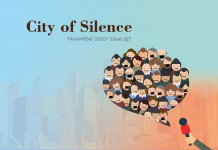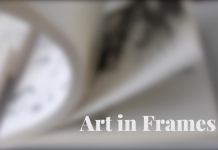Journaling using paper and pen adds colour to your life in today’s digital age
by Eunice Ip
A young woman sits at a table in the corner of a café, carefully writing in her journal with a fountain pen. She clips the leather-bound notebook shut after completing a few sentences and searches for stickers on a table scattered with stamps, rolls of fancy tape, memo pads, and watercolour brush pens.
Susie Hu Ruixin began journaling while on a student exchange in Austria two years ago. Hu felt something was missing in digital photos: they could not help record her feelings.
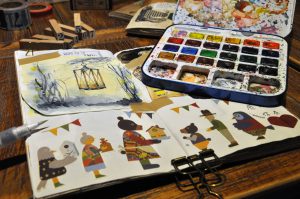
“At that time, I had a lot of travelling experience, and I started to think about how to organise it,” Hu says.
Like many other journal keepers, Hu, now 22, started out using the produced by Japanese stationer Midori. The original concept behind the notebooks was the appreciation of daily life as if it were itself a journey.
“You pay more attention to the details surrounding you, like collecting all the name cards, postcards in restaurants and attractions,” says Hu. She puts seemingly mundane items such as bus tickets or paper packaging into her journal because they prompt fond memories.
When she returned home from Austria, Hu’s grandfather embraced her Traveler’s Notebook as a treasure.
“He was really impressed and kept it as a very valuable gift for him. He pored over every picture and word,” she says.
His appreciation fuelled her growing enthusiasm for sharing her notebook. Last year, she started sharing her tips on journal decorating on the Chinese microblogging service Weibo. One original trick she devised involves using powder eyeshadow to create a singed page-edge effect instead of using real fire from a lighter to burn the paper. Hu’s Weibo account now has more than 58,000 followers, and has attracted advertising from some famous stationery and watch brands.
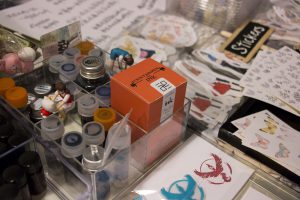
Although journaling is a hobby that utilises physical objects in the real world, social media plays a big part in spreading its popularity and connecting enthusiasts. Carmen Ho Sin-hang, who goes by the name Che Che on Instagram, has 6,000 followers on the social network. She is an 18-year-old decorative tape lover and designer who regularly shares posts about tape and her journal.
Ho started collecting tape in secondary school and uses it to decorate her journals. After her latest tape design was released – a vintage design featuring bus tickets – she got the idea of organising a tape market. She managed to gather 40 stalls through Instagram and attracted three times the expected number of visitors.
“I organised the market not just for buying and selling. I also wanted to give people a platform to exchange ideas,” Ho says. She hopes to encourage them to share their work, and appreciate others’ work. To that end, she set up an exchange zone where people could chat and display their work, and where tape, stickers and stamps were provided for free.
Journal keepers treasure these opportunities to meet each other in person. Earlier this year, the Traveler’s Notebook 10th Anniversary Exhibition was held at lifestyle store Log-On at Festival Walk. Local amateurs and experts joined those from Japan, Taiwan, and Singapore to share their experiences and get their hands on accessories and limited-edition notebooks.
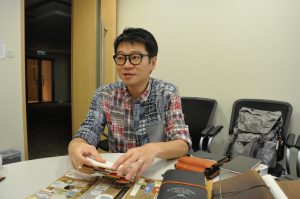
Patrick Ng Chi-him, the senior stationery merchandiser at Log-On, was one of the organisers. Ng introduced the notebooks and their concept to Hong Kong and has been promoting journaling culture over the past 10 years.
Ng says we pay too little attention to the things around us in our daily lives. “Everything becomes amazing when we go travelling, be it a chair, a coffee shop, or a piece of architecture. It is eye-opening because everything is new to us,” he says.
Ng explains the term “Techo”(手帳) used by most journal keepers in Asia, is a Japanese word that refers to notebooks, including travellers’ notebooks, diaries, schedule books and planners. He attributes the popularity of journals to the website moleskinerie.com, where fans of the Italian designed Moleskine notebooks showed off the writing, sketches and creative artwork they created in them. The site was later purchased by Moleskine.
“Moleskinerie.com inspires a lot of people and persuades others to take out a pen to write,” Ng says.
It may seem ironic that keeping a journal should be enjoying a revival in the digital age, but in a way it makes sense. Ng says paper has a unique physical presence. The feeling of receiving a text message or e-card differs from receiving an actual card. The capacity for storing digital data seems to be infinite but it can also seem ephemeral.
“When you store so many photos in your computer, you feel insecure. A physical notebook gives you a sense of security”, Ng says. “Technological advances will change production methods. But there will still be a pen and a piece of paper. We have to continuously educate our next generation to use them.”
Ng recalls how he used to make journals out of A4 paper when he was at school. It was easy to carry and fold. He was the editor-in-chief for his school publication, which was produced through real-time collaboration with schoolmates. Back then he had to draw illustrations and graphics by hand. Today’s design processes take place on computers and online without face-to-face communication, but Ng still enjoys doing things the old fashioned way.
“I am a visual person. I need visual memories,” Ng smiles.
As if to illustrate the point he shows Varsity his journals. Nearly every page is rich with visuals – there are maps, sketches and graphics. To Ng, a journal is a place where he can safely put down his thoughts and reflect upon himself. Journaling helps him to organise thoughts, clear his mind, and relieve stress.
“There are too many complicated things happening every day,” says Ng.
Pressure builds up easily when thoughts, feelings and tasks are confined to the mind. But when we list the tasks on paper, we are transforming what is on our minds into something tangible on paper. This provides a release from anxiety because we have a clearer idea on what is coming next.
Clinical psychologist Rebecca Cheung Wing-yan agrees that journaling can help to relieve stress. “I believe human beings are born with a need to express themselves by different approaches… Writing it down is one way,” says Cheung.
She explains that keeping journals helps us to recall the things that have happened and how we felt about them. The process prompts us to rethink issues and situations from different perspectives.
Journaling can help us make sense of the past by keeping a record of it, but it can also help us plan the future. Widely used time management apps and Google calendars can efficiently remind people of important appointments but using paper and pen allows people to create their own blueprint of time.
“If you need to introduce what a journal book is to an alien, just tell him it’s about how you schedule your own time,” says Ng Jay from the design group called Gun, Please Design.
For the past four years, the group of Chinese University of Hong Kong (CUHK) graduates has been designing a schedule book for CUHK students. This year, they shrank the size of the book to that of a traveller’s notebook instead of the conventional A6 size. They also made it slimmer and more portable by abandoning weekly organisation and basing their design on a yearly schedule. The designers eventually named their creation “Annual Techo” (年計手帳) but their initial choice was “Chronolog”, a log of time.
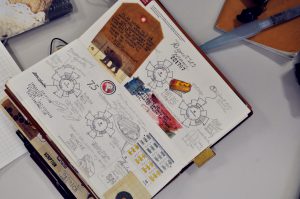
This chimes with Patrick Ng’s creation, the Chronodex time mapping system. Ng’s design is based on the idea of a clock over a 24-hour day. There are four layers in a Chronodex, representing the importance and urgency of work. Each 15 minutes counts as a session. Ng usually shades the Chronodex segments in different colours which indicate varying levels of urgency. For example, to him, red refers to something that is important but that he is reluctant to do; green means normal while blue means something he loves.
As the creator of the Chronodex system, Ng provides templates of his system for fellow journal keepers to download for free. It is a labour of love that he undertakes to help fellow journal keepers tackle their tasks in a stress-free manner, and also to unleash his own creativity.
“Other than relieving stress, journaling keeps you in control, to let you have time to be creative. We don’t have time to be creative since we are passive when things happen to us. When you can proactively manage your time, then you can be creative,” say Ng.
Edited by Cindy Gu




